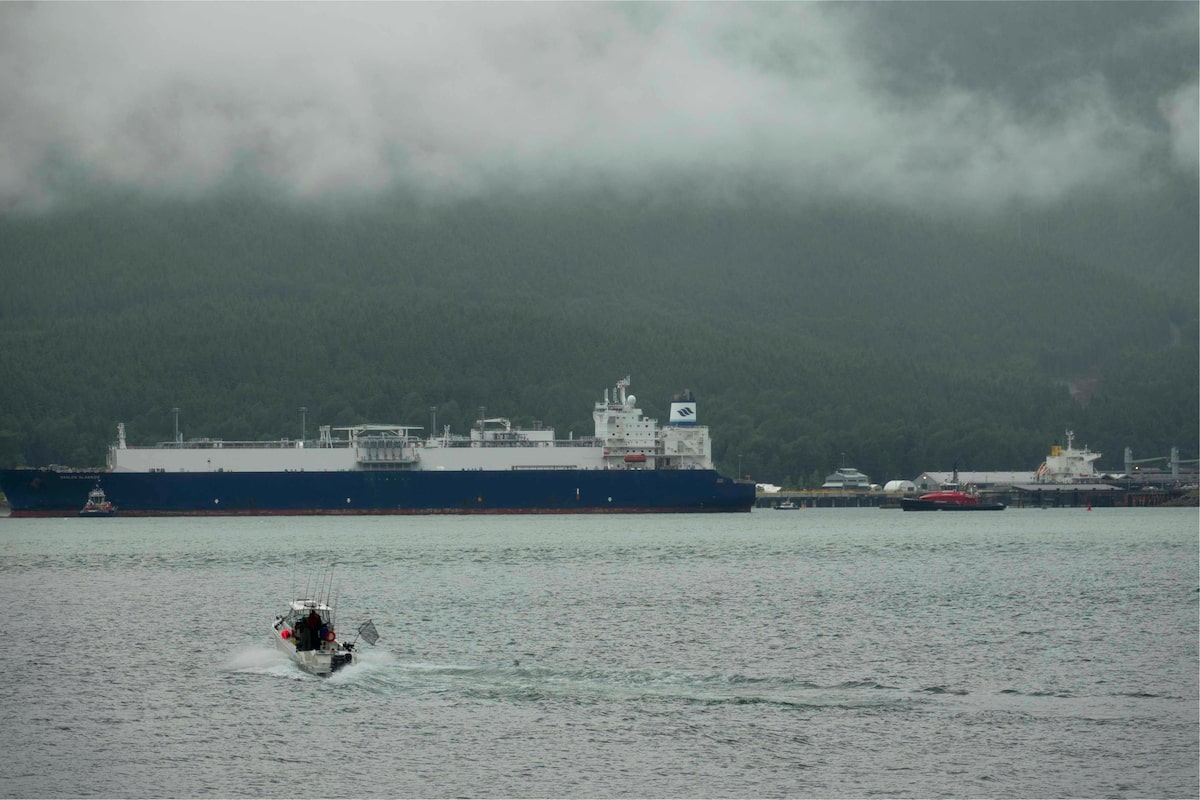The tanker GasLog Glasgow prepares to dock at the LNG Canada facility on its arrival at the Kitimat, B.C., harbour on Saturday. The GasLog Glasgow will carry the first liquefied natural gas shipment from the LNG Canada terminal to Asia.Robin Rowland/The Globe and Mail
A vessel has arrived in Canada to load the first shipment of liquefied natural gas from the new LNG Canada export terminal, marking a milestone after nearly seven years of construction in northern British Columbia.
The GasLog Glasgow tanker arrived on Saturday and after it fills up, it will depart with the first batch of LNG produced at the $18-billion terminal in Kitimat.
Chartered by Shell PLC, the ship is slated to set sail for Asia early next week. The vessel measures 291 metres in length and sails under the flag of Bermuda, according to MarineTraffic, a ship-tracking and maritime-analytics provider
After liquefied natural gas has been loaded onto the ship at LNG Canada’s marine terminal, it will be piloted nearly 300 kilometres out of Douglas Channel to ocean water by tugboat escorts.
It takes roughly 10 days for a ship to sail from Kitimat to North Asia, compared with 20 days from the U.S. Gulf Coast, via the Panama Canal.
Earlier coverage: As the U.S. trade war escalates, LNG Canada is poised to start exports to Asia
Political support for LNG gaining traction in Canada, Indigenous leader says
HaiSea tugs escort the LNG tanker GasLog Glasgow on its arrival at the Kitimat harbour on Saturday.Robin Rowland/The Globe and Mail
LNG Canada, which received its export licence in 2013, began building its terminal in 2018. The facility is located on a Kitimat industrial site on the traditional territory of the Haisla Nation.
At the peak of construction in 2023, the project required more than 9,000 workers on rotation in Kitimat. Large production modules that originated from China were installed at the export terminal.
The International Energy Agency released a report earlier in June that said LNG is cleaner than coal when accounting for greenhouse gas (GHG) emissions. “While there is a wide variation in the emissions intensities of coal and LNG, when all direct and indirect GHG emissions are factored in, we estimate that LNG results in about 25 per cent fewer emissions than coal across energy use cases of these fuels,” the IEA said.
The fossil fuel industry argues that LNG will play an important role in the energy transition, but climate activists say the world needs to focus on renewable energy, not on fossil fuels such as LNG.
“From installing heat pumps to building wind and solar power instead of new LNG projects, we have solutions to protect communities from worsening climate impacts,” Jens Wieting, Sierra Club BC’s senior policy and science adviser, said in a statement before the ship arrived in Kitimat.
London-based Shell is the largest partner in LNG Canada, with a 40-per-cent stake.
The other partners are Malaysia’s state-owned Petronas (25 per cent), PetroChina (15 per cent), Japan’s Mitsubishi Corp. (15 per cent) and South Korea’s Kogas (5 per cent).
Petronas mulls LNG Canada expansion as competition looms from Alaska
The total cost of building the entire project has been pegged at $48.3-billion, including the $18-billion Kitimat terminal, the $14.5-billion Coastal GasLink pipeline and other infrastructure, as well as annual budgets for drilling in the North Montney region of northeastern B.C.
